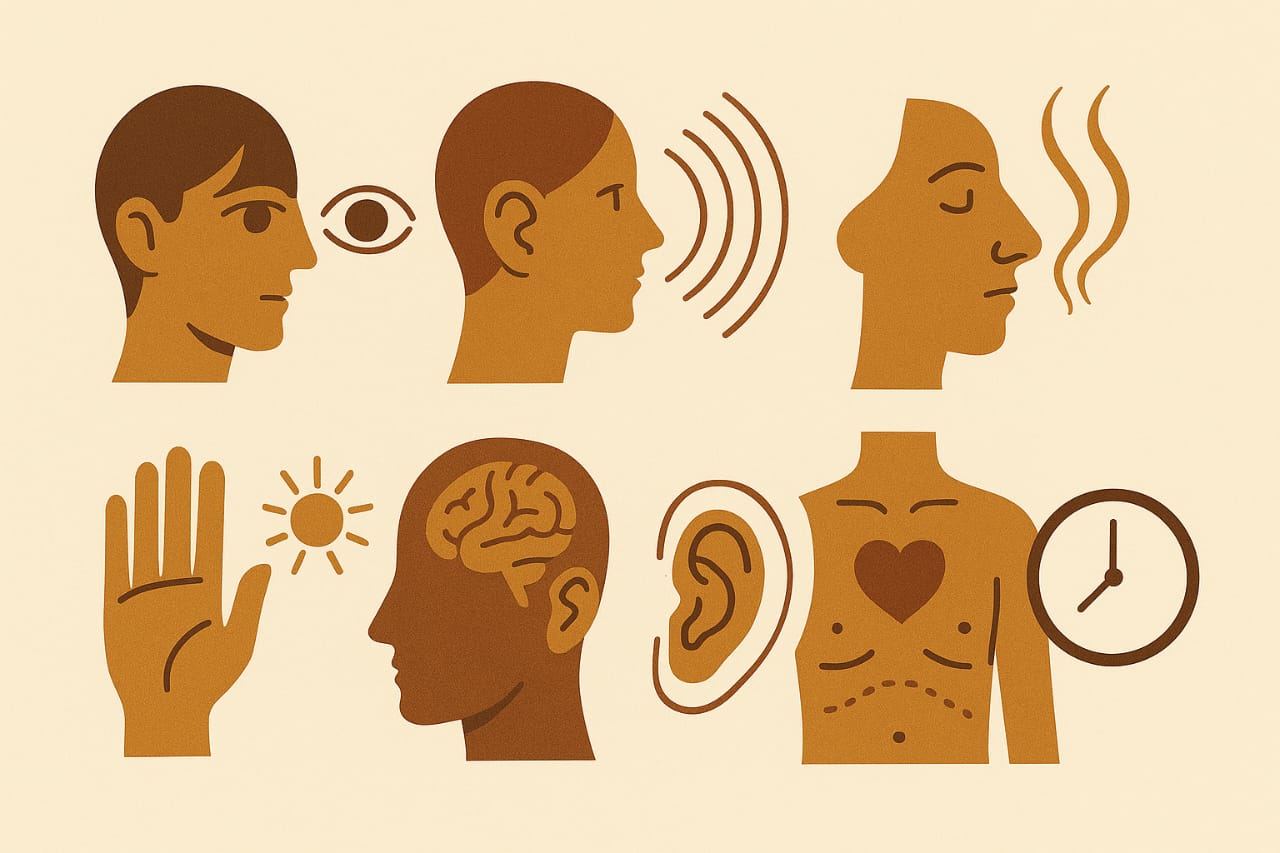By Ummehaani Zahir
We’ve all heard the classic schoolyard mantra: humans have five senses—sight, hearing, smell, taste, and touch. It’s as tidy as a perfectly packed tiffin box. But let’s be real—this is the sensory equivalent of calling a smartphone just a “calling device.” Science says otherwise.
Research shows we’re rocking at least 9 to 20 senses, depending on how you slice the sensory samosa. Your body isn’t just sniffing out biryani or dodging furniture—it’s a multitasking marvel, running a NASA-level control room of sensory data every second. Let’s unpack this superpower system with a dash of humor and a solid dose of science.
The “Five Senses” Legacy: Honoring Aristotle, but Expanding the View
The myth of the five senses dates back to Aristotle, who around 300 BCE In his work De Anima (On the Soul), decided that five was a nice, round number—and enough to describe how humans perceive the world. Sight, sound, smell, taste, and touch made the cut.
But here we are in 2025, sending probes to Mars and debating whether AI can write love sonnets, yet we’re still clinging to this ancient list?
Modern neuroscience has moved far beyond this simplistic view. A 2016 paper by philosopher and cognitive scientist Barry C. Smith argues that many of the so-called five senses are actually bundles of distinct sensory systems with different neural pathways and receptors. For instance, what we casually call “touch” includes pressure, temperature, vibration, and pain—each processed through different receptors and regions of the brain.
So, Aristotle? Respect, but your list is due for an upgrade.

Your Body’s Secret Sensory Superpowers
Your sensory system isn’t a five-piece band—it’s a full-blown orchestra. Here are some standout members:
- Proprioception: Your Inner GPS
Ever managed to touch your nose with your eyes closed? Or walked in the dark without smacking into furniture? That’s proprioception, your ability to sense the position and movement of your body parts without looking at them.
According to a 2002 Nature Reviews Neuroscience article, proprioception relies on proprioceptors located in muscles, tendons, and joints, which continuously feed spatial and kinesthetic data to your brain. It’s why you don’t trip while climbing stairs—unless it’s a Monday morning and you’re still half asleep. - Equilibrioception: Balance Boss
Your sense of balance, or equilibrioception, is managed by the vestibular system in your inner ear. This delicate setup includes semicircular canals filled with fluid that detect motion and orientation relative to gravity.
Stillman’s paper highlights how this system allows you to adjust posture, walk upright, and recover when you accidentally trip on a loose slipper. It’s the reason you can pass off a stumble as a “new dance move.” - Thermoception: Temperature Whisperer
Ever felt the heat from a plate without touching it? That’s not touch—it’s thermoception, your ability to sense temperature changes.
Barry Smith explains how specialized receptors in your skin (like TRP channels) detect heat and cold, independent of pressure or pain. It’s how your hand instantly knows not to grab that hot chai kettle—thanks, nerves! - Nociception: Pain’s VIP Pass
Pain isn’t just a grumpy offshoot of touch—it’s its own sensory system. Called nociception, it detects potentially damaging stimuli and triggers protective responses.
According to Smith, nociceptors are free nerve endings that sense extremes—sharp, burning, or aching pain—and send emergency signals to the brain. It’s basically your body’s red-alert button when you step on a Lego. - Interoception: Your Gut’s Gossip Line
Interoception is your internal body-monitoring system. It helps you sense hunger, thirst, heartbeat, bladder fullness, and even emotional states.
A 2020 study in Trends in Neurosciences explores how this internal feedback loop is especially critical in mental health. People with anxiety, for example, often experience heightened interoception, making normal bodily sensations feel overwhelming.
Whether it’s your stomach yelling, “Enough biryani!” or your bladder whispering, “Time to go, boss,” this sense is always tuned in. - Chronoception: Time’s Slippery SenseChronoception, or your sense of time, is still a bit mysterious. While there’s no single “time organ,” your brain uses multiple cues to estimate durations and intervals.
- Smith touches on how this perception is affected by attention, emotion, and context. That’s why waiting at the dentist feels like an eternity, but binge-watching four episodes of your favorite show flies by in a blink.
Why Are We Still Stuck on Five?
Because five is tidy. Textbooks love tidy.
Explaining 20 senses to students is like teaching a cat to fetch: possible, but chaotic. Imagine a quiz question: “Which of these isn’t a sense?”
Options: smell, pain, hunger, or sitting in the front row on day one.
(Spoiler: only one of them isn’t backed by neurons—it’s just regret.)
Simplifying for education is understandable, but it underestimates the remarkable complexity of the human body. We’re not operating on a five-channel system—we’re more like a satellite dish pulling in a dozen frequencies, simultaneously.
Final Thought: Time to Level Up Your Sensory Knowledge
So next time someone throws out the old “five senses” line, flash them a knowing smile and say: “Actually, my body’s running a 20-tabbed browser of perception.” You’re not just reacting to sights and sounds—you’re processing pressure, heat, balance, internal states, and even time—all without a single coffee break.
Aristotle may have started the conversation, but science has taken it to another level.
References
Smith, B. C. (2016). The chemical senses. Philosophical Transactions of the Royal Society B: Biological Sciences.
Stillman, B. W. (2002). Proprioception and the sensory-motor system. Nature Reviews Neuroscience.
Quadt, L., Critchley, H. D., & Garfinkel, S. N. (2020). The neurobiology of interoception in health and disease. Trends in Neurosciences.

